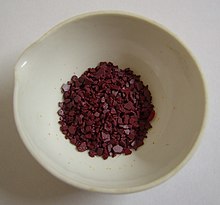Sarett oxidation
| Sarett oxidation | |
|---|---|
| Named after | Lewis Hastings Sarett |
| Reaction type | Organic redox reaction |
| Identifiers | |
| RSC ontology ID | RXNO:0000547 |
The Sarett oxidation is an

History
First appearance

The reaction is named after the American chemist
Modifications and improvements
Although the Sarett reagent gives good yields of ketones, its conversion of primary alcohols is less efficient. Furthermore, the isolation of products from the reaction solution can be difficult.
Preparation of the Sarett reagent
Techniques

The Sarett reagent was originally prepared in 1953 by addition of chromium trioxide to pyridine.[3] The pyridine must be cooled because the reaction is dangerously exothermic. Slowly, the brick-red CrO3 transform into the bis(pyridine) adduct. Subsequent to the conversion to the Sarett reagent, it is immediately used.[3]
Safety

The specific methods of the reagent's preparation are critical, as improper technique can cause the explosion of the materials.[6] Some technical improvements to the original methodology have reduced the risks associated with preparation. One such recent improvement reduced the likelihood of explosion by using chromic anhydride granules that would immediately sink below the surface of the cooled pyridine upon addition.[2] It should also be mentioned that chromium trioxide is a corrosive carcinogen and therefore must be handled with extreme care.[7]
Collins technique
The original Collins oxidation calls for the Sarett reagent to be removed from the excess pyridine and dissolved in the less basic methylene chloride.[4][6] While the new solvent improves the overall yield of the reaction, it also requires the dangerous transfer of the pyrophoric reagent. The 1970 Ratcliffe variation reduced the risk of explosion by calling for the Sarett reagent to be made in situ. This was achieved by creating the Sarett reagent according to the original protocol using a stirred mixture of pyridine and methylene chloride.[5]
Specific applications
The Sarett oxidation efficiently oxidizes primary alcohols to aldehydes without further oxidizing them to carboxylic acids.
See also
References
- ^ Margareta Avram (1983). "Chimie organica" p. 472. "Editura Academiei Republicii Socialiste România"
- ^ S2CID 97957064.
- ^ .
- ^ .
- ^ .
- ^ ISBN 978-0-387-23607-0.
- ^ "Chromium Trioxide (MSDS)". J. T. Baker. Retrieved 2007-09-13.
- ^ "Jones Oxidation". organic-chemistry.org.
